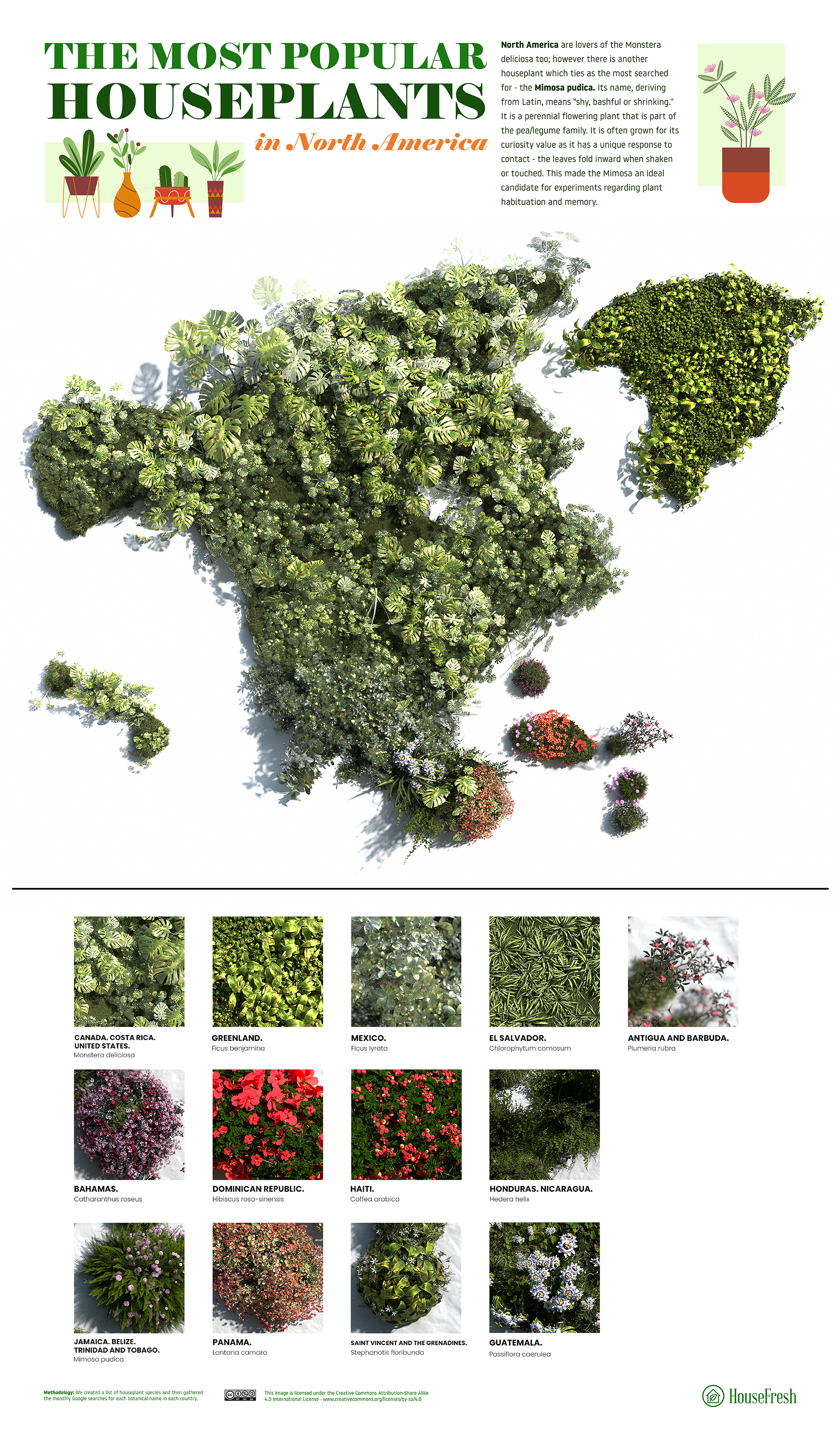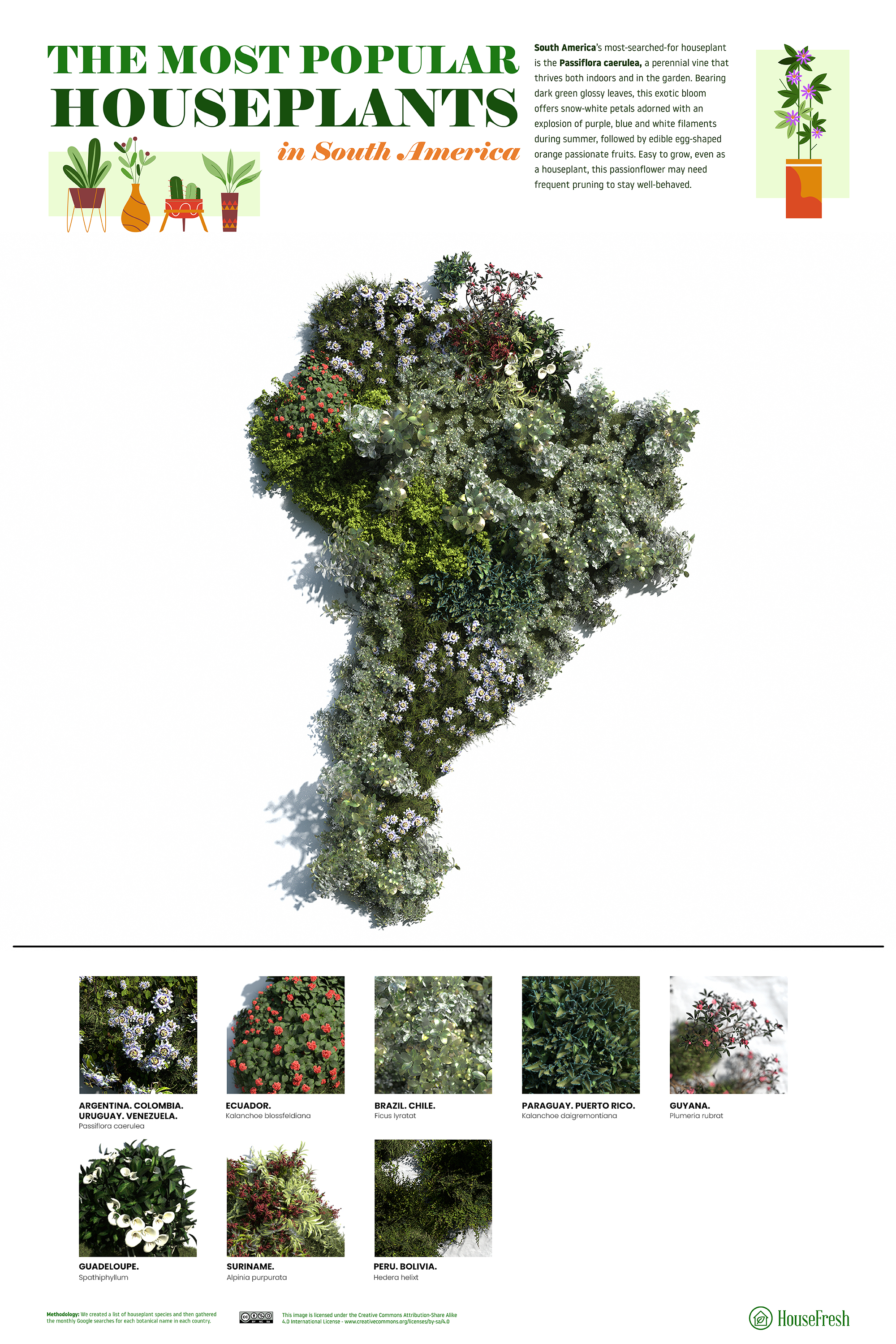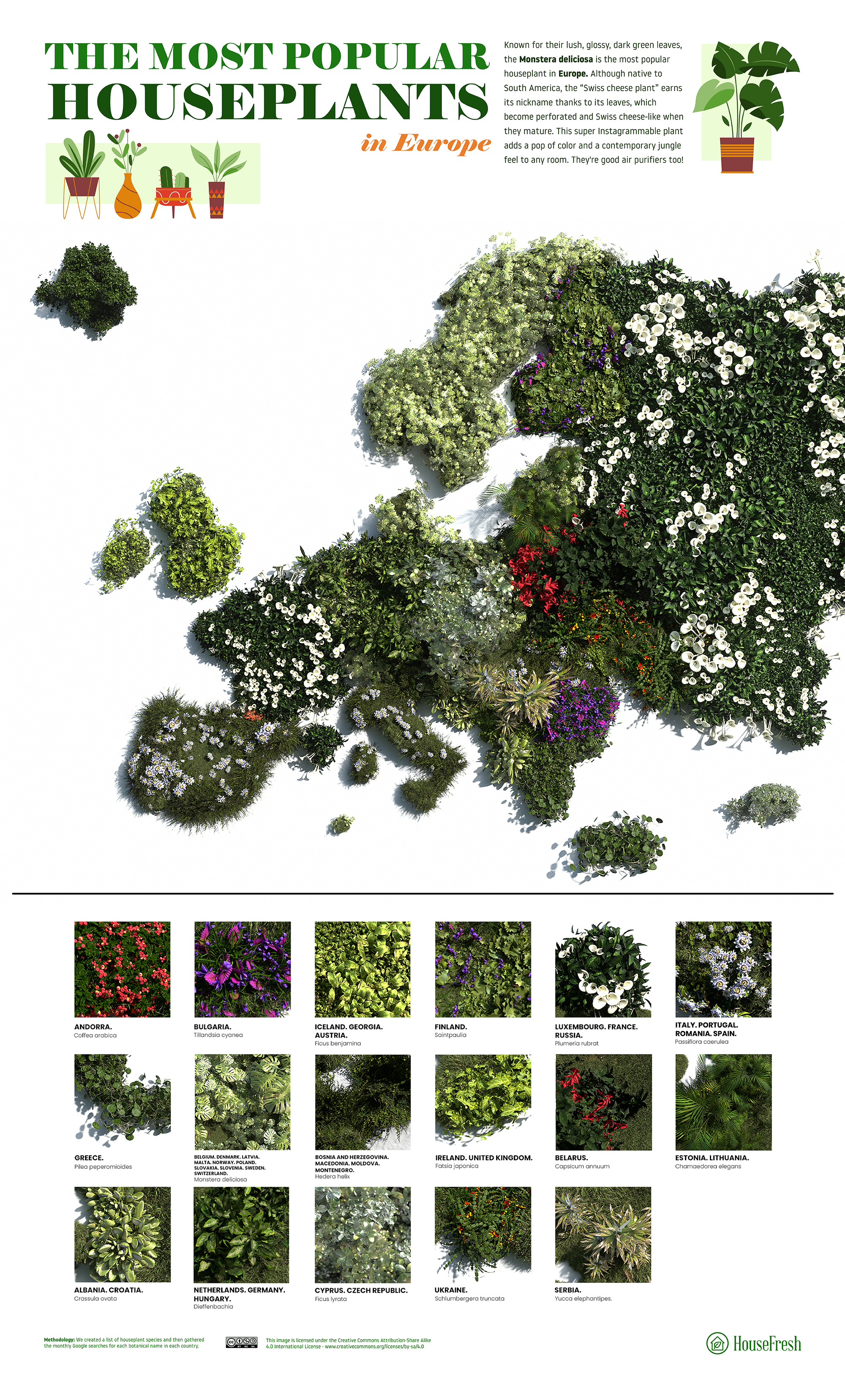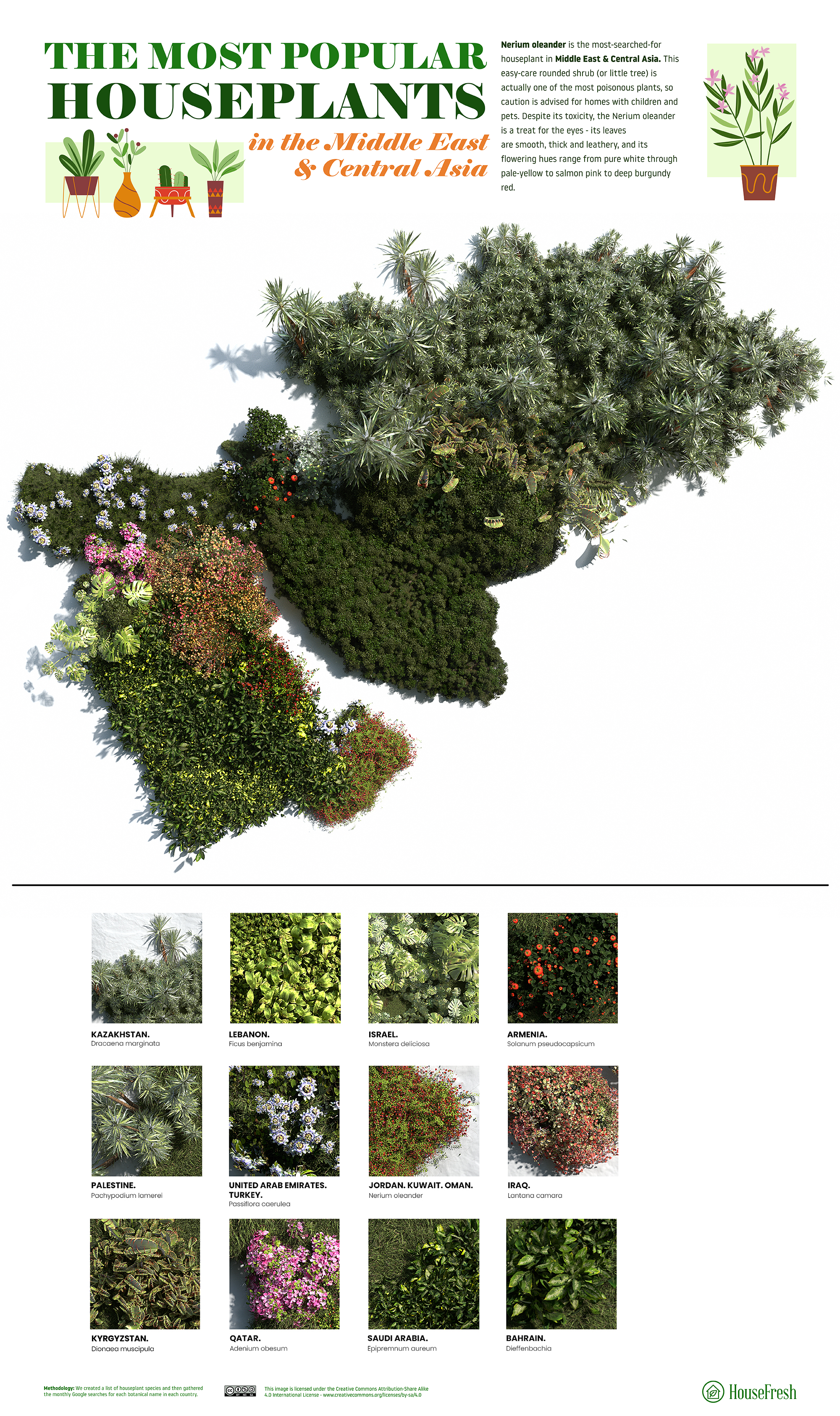As a member of the FlyerTalk community, I have visited the homes of friends all over the world — and the natural thing to do when one sees the interior of a house or apartment for the first time is to look around and notice what is inside: types of furniture; entertainment options, photographs and tchotchkes which were collected from their travels worldwide over the years…
Which Are the Most Popular House Plants in Different Parts of the World?
…and the types of plants which are inside of their homes — which brings up the questions: which are the most popular house plants in different countries around the world?
Did you know that different types of house plants are favored in different parts of the world?
To answer that question, a list of popular house plant species was curated based on a seed list of the 230 houseplants which were featured the most on Instagram across the globe, according to research from NeoMam Studios for Budget Direct Home Insurance.
The monthly Google search volumes for each botanical name in each country was then gathered using Ahrefs Keyword Explorer. Where several species had the same number of searches in a country, the one with the lowest global search volume was chosen.
The data was collected in October 2021 and November 2021.
I have been given express written permission to use the graphics and the verbatim text from this article written by G. John Cole for HouseFresh, which highlights what are the most popular house plants in different countries around the world. While HouseFresh has endeavored to ensure the information provided is accurate and current, it cannot guarantee it. Neither HouseFresh nor The Gate accept liability for the information which is presented in this article.
The Most Favored House Plants in Different Countries Around the World
It’s the romance of the century: the houseplant has wrapped its tendrils around humanity’s heart, and it won’t let go.
The millennials started the affair. Filling their rental properties with greenery. Taking ‘shelfies’ to supplement their Instagram selfies. Then, annual gardening revenue in the US grew by 4.62% in 2018, as Gen Z left home and joined the houseplant craze. And just like any other relationship, the pandemic intensified things. In 2020, growth nearly doubled to 8.79%, with stores swamped by ten times the daily orders they expected.
Along with the pandemic, plant passion went… well, if not viral, then rhizomatic, spreading and sprouting in countries around the world. An indoor plant is a hobby, a shoulder to cry on, a rosary for our existential fears, and an interiors flex on Zoom. So the world bought houseplants.
But some houseplants get more love than others. HouseFresh analyzed Google search data for the 230 most-Instagrammed houseplants to find out which one is the most popular in every country around the world. And we mapped every one, lining each territory with its most-searched houseplant.
Key Findings
- The Monstera deliciosa (Swiss Cheese Plant) is the number one plant in Europe, Asia & Oceania, and a joint favorite in North America.
- The colorful Passiflora caerulea (Blue Passion Flower) is most popular in South America. This semi-evergreen climber is the national flower of Paraguay.
- Africa’s favorite houseplant is the Lantana camara, an evergreen flowering shrub within the verbena family.
- In the Middle East and Rest of Asia, they favor the Nerium oleander, an evergreen ornamental shrub that has been cultivated since ancient times and features in many of the Roman wall paintings in Pompeii.
North America
A monster is stomping all over North America. Monstera deliciosa is the most popular houseplant in Canada, Costa Rica, and the United States. The giant, hole-ridden leaves covering much of the continent map below have earned Monstera the nickname Swiss cheese plant. The fruit is indeed edible – tasting of paradise if ripe and bleach-like if unripe. (And not of cheese.)

Mimosa pudica is also favorite in three countries: Jamaica, Trinidad and Tobago, and Belize. Known as the sensitive plant, its grey-green leaflets will shy away if touched, and its alternative nickname – shame plant – makes it the perfect confidant for your own festering self-hate. Plus, the pudica’s lilac pom-pom flower is quietly stunning.
South America
The blue passionflower is a multi-story bloom with tremendous architectural flair. The aerial view of Passiflora caerulea covering Argentina, Colombia, Uruguay, and Venezuela below cannot do justice to the manner in which the passionflower reinvents itself from leaf to petal base to reflex circle to coronal filament. The plant’s name is inspired by the suffering and death of Jesus Christ, and its tendrils cling to walls and trellises, making for a serious welcoming party at your front door.

Although the blue passionflower is Paraguay’s national flower, it is not the nation’s top houseplant. Paraguay and Puerto Rico both search for Kalanchoe daigremontiana more than any other greenery. The “unique and undemanding” mother of thousands is nicknamed for the endless plantlets that appear along its leaves. This ribbed effect also earns the plant the name of Devil’s backbone or alligator plant.
Europe
Much of Europe has been conquered by the Swiss cheese plant. Ten countries, including Switzerland itself, search for this houseplant more than any other. Which is a good chance to add a factoid on North America and Europe’s favorite shelf candy: its Swiss cheese holes evolved to filter sunlight through the rainforest canopy onto each leaf more or less equally, keeping the plant healthy all over and not just at the top. Try it with your Anglepoise lamp!

The second-most common favorite plant in Europe is the Hedera helix, the most-searched in four Balkan countries (Bosnia and Herzegovina, Macedonia, Moldova, Montenegro). Well known as Common orEnglish ivy, it makes a great indoor plant since it tolerates moderate light, clears the air, and there is an enchanting range of leaf varieties to enjoy close-up. Plus, common ivy can be cultivated to fill a range of spaces and interior terrains.
Middle East & Central Asia
It looks Asian, the Romans painted it all over ancient Pompeii, and it grows magnificently in the cooler temperate climates of the UK or New Zealand – but Nerium oleander is so popular that nobody knows where it began. Simply known as oleander, this evergreen shrub is an eyecatcher in red, pink, purple, or white, but it’s highly toxic, so best kept away from cats, dogs, and toddlers. Oleander is favorite in Jordan, Kuwait, and Oman, the highest number of countries for a houseplant in this region.

Palestine favors an unusual succulent called Pachypodium lamerei. Translating as ‘thick-footed,’ the plant’s stems swell with water storage tissue protected by sharp spines up to 5cm long. It also photosynthesizes through these stems. Should it be damaged, the lamerei bleeds white sap profusely. Way up over its impressive foot-trunk, joyful leaves sprout, which — along with the plant’s exotic origins — wins it the common name, Madagascar palm.
Rest of Asia & Oceania
The top houseplant in this region is again the Monstera deliciosa, which is the most popular in 11 countries. But the pandemic has fueled a growing passion for searching out rarer plants, as one Thai nursery owner explains: “It varies from person to person. Some people like to have something a bit different, others just love the thrill of the chase.”

Japan is the only country in the world to favor the Kalanchoe tomentosa. It’s a cute one. The perennial succulent’s furry green leaves have dabs of brown on the end, earning it the name panda plant or chocolate soldier. The chocolate soldier (yes, we’re going with that one) originates from Madagascar, and in cooler climates, it actually needs you to have it indoors with you to keep it warm.
Africa
Lantana camara is the number one houseplant in 12 African countries. Its flower explodes in shades of red, orange, yellow, blue, white, and pink, releasing a scent that divides audiences into two camps – those that think it smells pleasantly fruity versus those who detect cat pee-like undertones. Lantana is considered by many to be a weed as it has spread eagerly through areas where it is unwelcome. But this fecundity just shows how easy it can be to grow from scratch.

The island country of Cape Verde takes a pretty dwarf tree, Polyscias fruticosa, as its favorite houseplant. Known also as Ming Aralia, the perennial can grow to a couple of meters in height but lends itself to the art of bonsai (pot plant ‘training’). Its fern-like leaves more than make up for the fact that the Ming Aralia rarely flowers indoors.
Love Life, Love Plants
The present houseplant boom reflects the times in which today’s young adults have grown up – and the future that we face. An instinct has kicked in to surround ourselves with greenery and to ‘nurture nature.’ However, the trend can backfire when the same capitalistic forces that got us here manifest in the houseplant ‘industry.’
To keep indoor plants responsibly, experts suggest:
- Buying local to reduce ‘plant miles.’
- Rejecting plastic pots in favor of recycled and recyclable materials.
- Avoiding retailers who use peat.
With that in mind, here’s the full data on the favorite houseplant of every country around the world… dig in!
Final Boarding Call
House plants have always important to me. In addition to adding a natural aesthetic to the interior of a home which is otherwise closed off to the outside world, live house plants also help to provide cleaner air…
…and I have a special appreciation for indoor plants which also bear fruit, vegetables, and herbs — which is like getting a bonus.
Many house plants are fairly easy to maintain: usually, just water them once a week; and keep them in an environment where they will thrive the most — such as in a sunny spot on the window sill or in a shady area in the corner.
If it is at all possible, perhaps get a house plant which is indigenous to a country which you visited in the past that will act as a prompt for the memories to return about your experiences in that country.
Photograph ©2020 by Brian Cohen.

